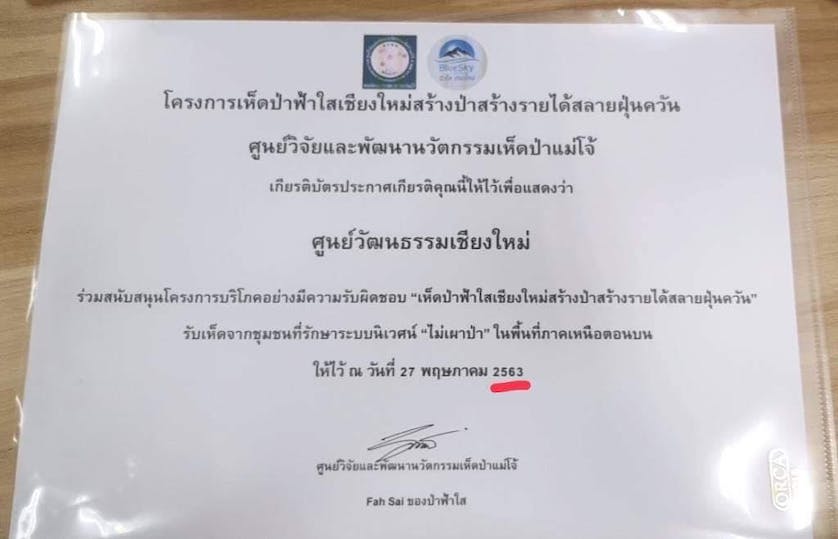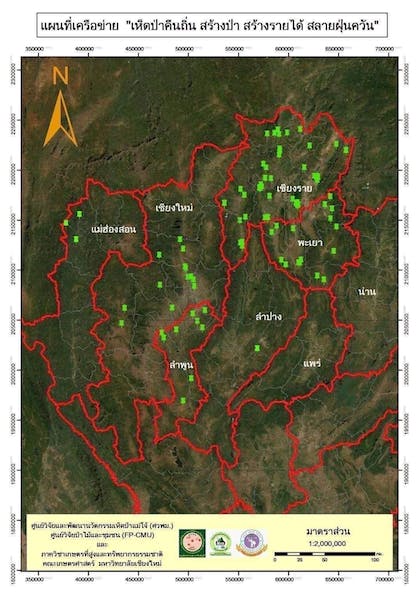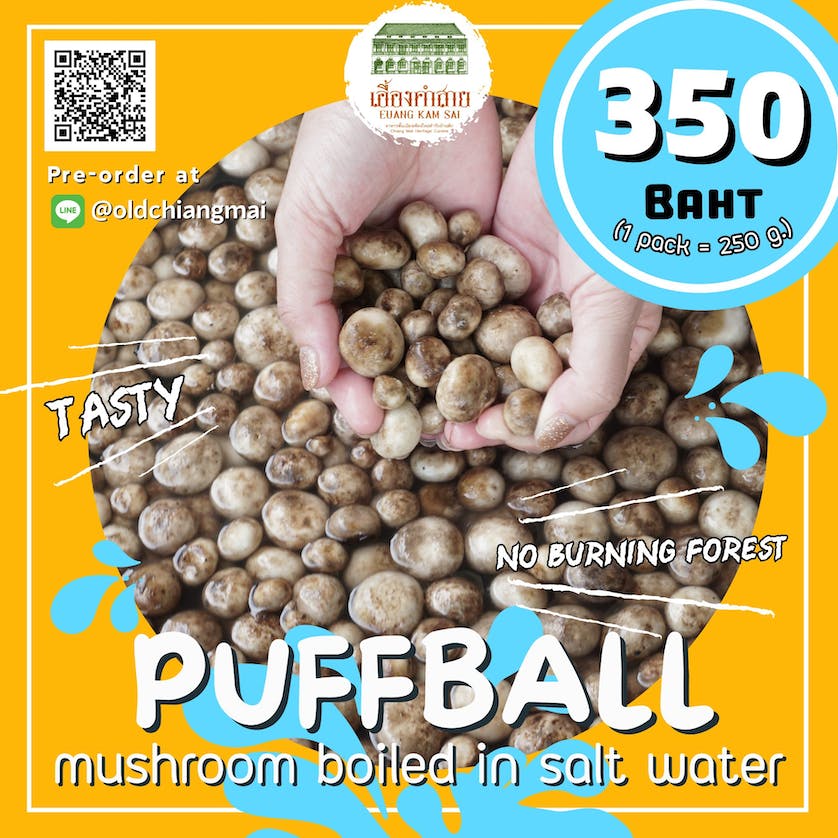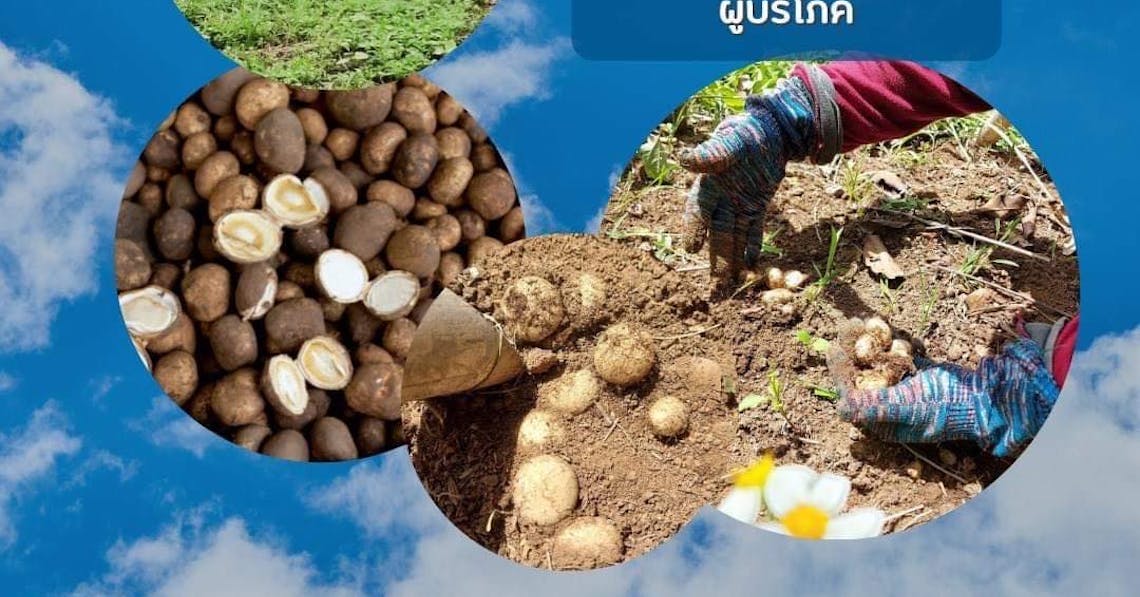Over the past two decades Citylife has been active in the fight for clean air here in Chiang Mai and the north of Thailand, having published our very first article in 2005, titled ‘Solution to Pollution?’ which we believe to be the first feature written about the air pollution crisis in our region in any mainstream publication. We have since published hundreds of news items, opinion pieces, investigative stories and calls for action in the ongoing fight and will continue to do so for years to come.
After decades of being involved in the anti pollution movement we have learned that this is a very complex matter with multiple players each of whom has convoluted and tricky relations with one another and the various sources of PM2.5 particles. It is beyond clear there is no one simple solution to this problem.
On Monday Citylife published a news story reporting on how hed thob, botanically known as Astraeus hygrometricus (sometimes called Thailand’s truffle, or earth star mushroom) sales prices have 675been skyrocketing across Chiang Mai, this week reaching over 800 baht per litre, (as we have done multiple times over the years as prices have risen and fallen such as here https://www.chiangmaicitylife.com/citynews/local/hed-thob-mushroom-prices-skyrocket/). We were, however, concerned to read of a handful of comments by some readers who took great exception to our news report, going so far as to accuse us of promoting the burning of forests and causing environmental harm by reporting on current mushroom prices. We thought it time to shed some light on yet another complex issue and hope some of the people we have talked to can explain why we should refrain from jumping to condemn mushroom eaters and buyers (as well as anyone else to be fair) before learning more about the situation. The burning of the forest in search of mushrooms has, for the past decade or so, been one contributing factor of the annual air pollution crisis, with one Bangkok Post article from 2015 claiming that up to 18% of the pollution came from this sauce. This number, however, has not been corroborated by anyone Citylife has interviewed. Though we are sure that there have been many instances of illegal burning in the hunt for mushrooms, and we have published many articles discussing and condemning this practice, there has also been a lot of work done in recent years to change this behaviour and to reduce its impact. So here are some voices from the hed thob mushroom/air pollution worlds.
Citylife is learning along with you all, as new information emerges and while we too used to thoroughly condemn all consumption of hed thob, with new data, comes new understanding and we hope that after you read this article you will join us in supporting ethical hed thob consumption and enjoy what our northern forefathers have been enjoying when the rains arrive every year for centuries.
“The burning has already been done, so yes, I am sure there has been damage done already as some burnt the brush unnecessarily during the hottest time in the mistaken belief that it generates growth. This is not true. So if they burn now so that it is easier to see them, the rains are here already so we are not going to be affected by that. But we don’t in fact know how much exact damage is caused annually by the burning of these mushrooms,” Steve Elliot, co-director of the Forest Restoration Research Unit (FORRU-CMU) in Chiang Mai.
“Our project has been running for four to five years,” said Sumit Athiprom, researcher at the Maejo Wild Mushroom Research and Innovative Development Center (MWRIDC) at Maejo Universit . “It is a joint project between Maejo and Chiang Mai Universities whereby the results of our research works are piggybacking firefighting, pollution fighting and community forest development efforts being used in communities throughout the north of Thailand to help reduce air pollution from burning for mushrooms.”

Certification of participation in project
The Maejo Wild Mushroom Research and Innovative Development Centre, Faculty of Agriculture Production, Maejo University has spent the past few years researching hed thob. “We have found this mushroom to be extremely high in protein which makes it an excellent food source. It also has a long standing tradition in our culinary culture, being an important heralding of the rains following a long hot spell. We have also proven definitively that burning is bad for its cultivation, not only degrading the soil which means fewer mushrooms in the coming seasons, but also producing smaller mushrooms after fire. We have also proven that areas which are burnt will be slower to produce more mushrooms in the next season, often by over a month. So while some desperate people may think that burning the forest will allow them to spot the mushrooms easier, therefore making it easier to harvest, this is a fallacy as it is not in anyway sustainable. We have been educating people for about five years now about this matter, conducting workshops and training countless times. With these high prices, our foragers could do very well indeed if they made a proper living off it. To that end, we have produced mushroom fungi and have been distributing them https://www.chiangmaicitylife.com/citynews/local/mushrooms-from-maejo/ to villagers which care for their local community forests across the north. A total of 200 villages managing 20,000 rai of community forests have opted to be part of this programme. To date we have discovered an 80% reduction in hot spots found in these community forests since the inception of our programme. This proves beyond a doubt that it is working.”

Sumit went to say, “Research has shown that in many areas mushrooms growth is reduced by up to 10% year on year because the forests are not properly cared for. We have been spending the past five years training communities on how to optimise soil for mushrooms, advising them on where the best areas are to find mushrooms (under large trees with little floor growth in a healthy moist forest) give tips on how to best harvest mushrooms (always leave some behind for the following year), find marketing channels for the foragers, all of which should see villagers be able to make a good living off mushrooms and for our consumers in the city to be able to enjoy this traditional, healthy and delicious mushroom.”
“Earth star mushrooms takes a lot of skill and labours to collect. You need to know the geography, the forest and the type of mushroom itself. These mushrooms have relationships with big trees. Basically you need an intact forest with big trees to be able to harvest the best and most mushrooms. And guess what? It has no relationship with burning. Unlike palm, unlike sugarcane, unlike corn. To rope all of that into the same category as things that destroy forests is just stupid. So how do we have intact big trees in the forest with highly skilled people collecting it. That is the delicacy of this mushroom. It is great, it is crunchy, high protein, cheesy and on top of that it has a very low shelf life. It is a great delicacy. So if we encourage the eating of it ethically it could be good for the forest and give good income. If the earth star is the star in this story then you need big trees. The community forests contribute to the welfare of so many poor people who love that forest and use that forest for generations. Earth star comes in as a product which fits in with so much good we are doing. Why is it seen as so bad?” Were the words from Po Garden, retired ecologist and farmer.

More mushrooms from healthier forests
“Personally I don’t eat them but since the fires are the government’s and companies’ business, I think it is probably ethical to eat them,” said Michael Shafer Director of Warm Heart Foundation, universally acknowledged to be one of the vanguards in the charge for cleaner air. “My inclination is to attribute the burning to arsonists hired by companies big enough to export to China, where burning is strictly forbidden (pain of death) but demand is high. Why prices have spiked, I have no idea, but certainly the offered excuse is lame in as much as this had always been the case but this is the first time for such prices. Yes the rains are here and this should stop the fires. I can not imagine how people thought you were promoting burning.”
“Here in Chiang Mai there are thousands of community forests, areas carved from the national park, with licensed documents, which allow communities to care for, work on and benefit from community forests. These are the areas we have been working in. If they forage in the national forests they will be arrested. Just look at satellite hot spots, we are not seeing fires on community forests, but in national parks. So we are trying to make sure that we can reassure the public that they are not supporting the burning of forests by eating these mushrooms as we monitor where they come from and we support the ethical foraging and sales of them. It is clear, there is hardly any burning in community forests as a result from hunting mushrooms. Most of the hotspots this year were in national parks. Community forest communities are strong and should be supported, not condemned,” added Sumit.

Communities working with the environment rather than against it
“Like most serious issues, there are nuances,” Kim Chutima director of Old Chiang Mai Cultural Centre, a centre for distribution of ethical hed thob, told Citylife. “We can be a part of sustainable consumption by supporting locals who maintain the integrity of the ecosystem. Let’s forget any misunderstandings about wild mushrooms and become part of a new cycle.” Kim’s restaurant Eung Kham Sai sits in Old Chiang Mai and not only serves up ethically-sourced traditional hed thob dishes, it is also an official outlet for environmentally responsible hed thob sales, supplying kitchens around Chiang Mai.
“Yes of course there are people who are irresponsible and burn the forest floor in a quick grab for mushrooms,” added Sumit. “Bad behaviour is inevitable, but we have the law to punish this behaviour, we have education and training to deter it and offer better choices, we now have partner restaurants in the city who are buying responsible and ethical mushroom foraging to support good behaviour. And of course we are monitoring and fighting forest fires. So yes, sure, you can condemn the practice of burning for mushrooms, we all do. But that would be ignoring the huge amount of work that has been done by so many of us, as well as the great awareness now of people who are concerned about the environment. Bad behaviour at the forest is proven to reduce the richness of its harvest. This means that communities will begin to police itself for the greater good of the whole community. Condemn people, not mushrooms.”

Order your guilt-free mushrooms here
At this point we were unable to find definitive data as to how much mushroom hunting contributes to the annual pollution. No one interviewed for this article has claimed to have seen this data, though Sumit said that he hopes to be able to produce data after more information has been collected. So while there is a lot of blame being flung about, and quite rightly, perhaps take a moment and look at the matter from multiple angles, listen to multiple voices and support those who are doing the right thing while condemning illegal behaviour. Our opinion is that we love hed thob and now that we know we can eat it without any damage to the environment, we will be heading to Old Chiang Mai to get some!
